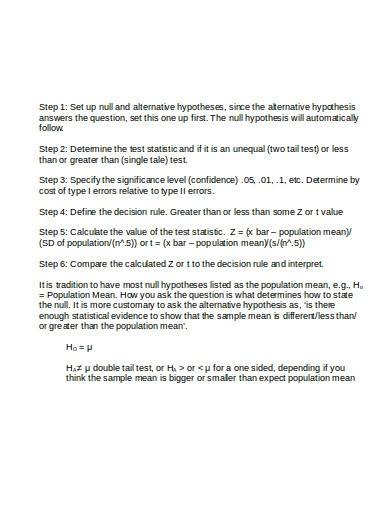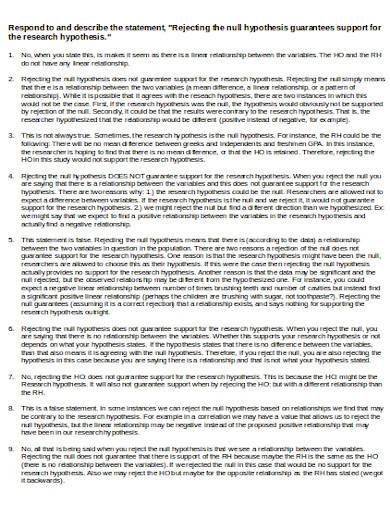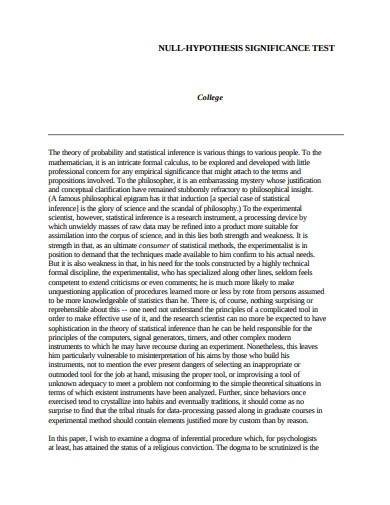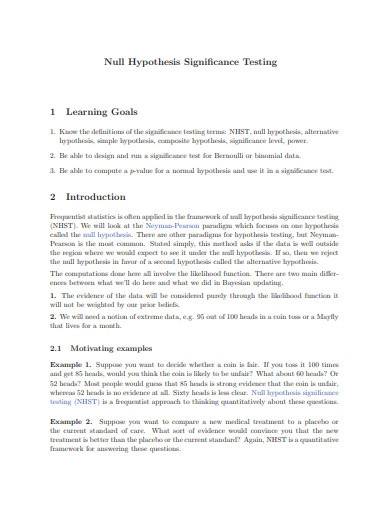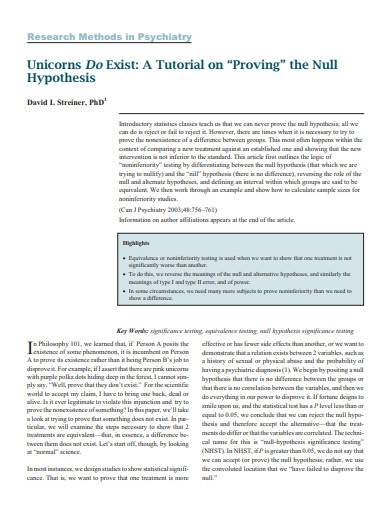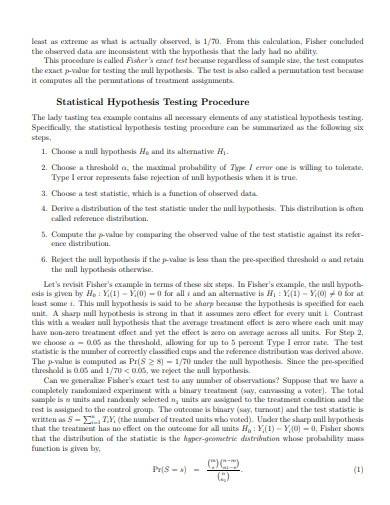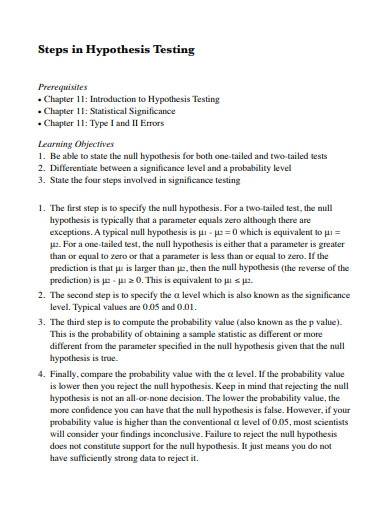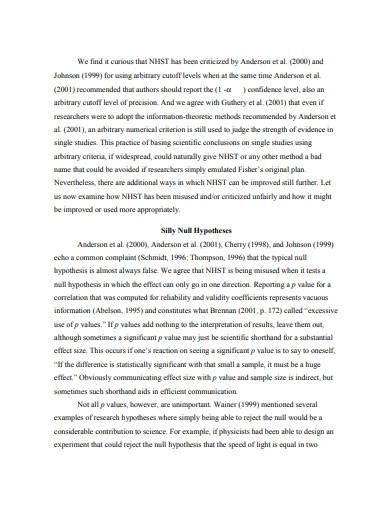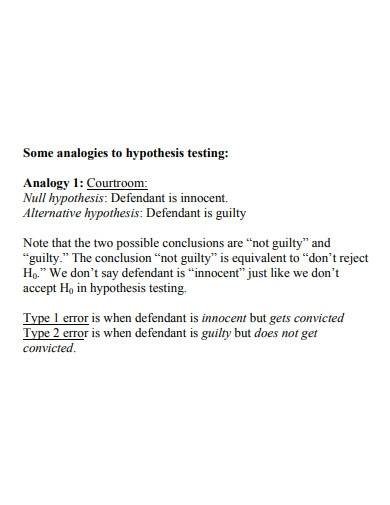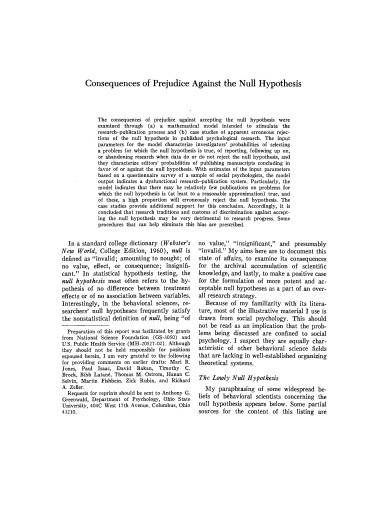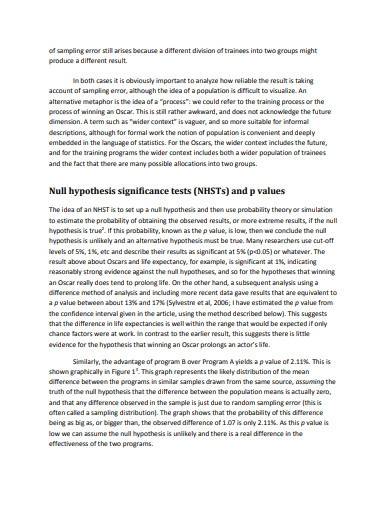A research hypothesis is a statement that tells a prediction of what a scientific research paper is expected to achieve as the result of its study. This statement is a temporary answer to the research paper’s question that has not yet been tested. Some research projects include several hypotheses that explain or discuss various areas of the research question or problem statement. One of the different kinds of hypotheses is the null hypothesis which is a statement that tells that there is no difference between groups of people or populations or no relationship between two variables.
FREE 10+ Null Hypothesis Samples & Templates
1. Null Hypothesis Template
2. Research Null Hypothesis Template
3. Null Hypothesis Significance Test
4. Sample Null Hypothesis Significance Test
5. ResearchNull Hypothesis Sample
6. Hypothesis Testing Procedure Template
7. Hypothesis Testing Overview Template
8. Research Null Hypothesis Format
9. Sample Analogy Null Hypothesis
10. Prejudice Null Hypothesis Template
11. Null Hypothesis Significance Test Review
What is a Null Hypothesis?
A null hypothesis is a statistical hypothesis that suggests the absence of a statistical significance between a set of given observations. This type of hypothesis is commonly used in quantitative analysis or quantitative research to analyze theories relevant to business topics such as target markets, investing strategies, marketing strategies, or economies to determine whether an idea is true or not. A null hypothesis can be tested by utilizing statistical analysis as well as a significance test which researchers use to determine the possibility of the results supporting the null hypothesis not because of coincidence.
How to Conduct Null Hypothesis Testing
Null hypothesis refers to the accepted fact that may or may not be tested and proven. In its initial claim, the null hypothesis assumption is considered to be valid. This hypothesis verifies the relevance of the statistical data that is used as a sample which is compared to the characteristics of a whole population where the sample was taken. Researchers can determine whether or not to prove a statement by performing hypothesis testing.
Step 1: Write the Study’s Null and Alternative Hypotheses
Once you have developed your initial research hypothesis, restate your null and alternative hypotheses. An alternative hypothesis predicts the possible relationship between different variables while the null hypothesis predicts the absence of this possibility.
Step 2: Gather Relevant Data
Performing sampling and gathering data is a method used to test hypotheses as well as for statistical analysis or tests to be valid. Without the representative data, you will not be able to make statistical inferences about your preferred population.
Step 3: Conduct a Statistical Test
You can utilize various types of statistical tests but you have to consider the comparison of within-groups and between-group variances. Choosing the appropriate statistical test will depend on the type of variables and the level of measurement of your gathered data.
Step 4: Provide the Findings
After deciding whether to fail or reject the null hypothesis, you can now present your research’s findings. The results will be written under the results and discussion section of the research paper, thesis research proposal, or dissertation.
FAQs
What are hypothesis tests?
Hypothesis testing refers to the formal procedure of analyzing and investigating ideas about different subjects or topics using statistics. This type of testing is commonly used by scientists to examine certain predictions which are hypotheses by determining the possibility that a relationship between two variables occurred by chance.
What are the different kinds of the null hypothesis?
The different kinds of null hypotheses include the simple hypothesis, composite hypothesis, exact hypothesis, and inexact hypothesis.
How do I state the null hypothesis?
To state the null hypothesis, you can start by determining the hypothesis from the research problem statement, converting the hypothesis into math, and stating the consequences if the hypothesis does not come true.
Null hypotheses act as the base for leading scientific research. Determining null hypotheses helps in identifying the logic behind statistical significance testing, proving or disproving relational statements, facilitating alternative hypothesis testing, and confidence intervals, and can be applied to different fields of study. This hypothesis is important for validating sample data that is relevant to population data. It also helps in coming up with essential conclusions in medical science, psychology, statistics, and research.
Related Posts
FREE 10+ Concurrent Validity Samples & Templates in MS Word | PDF
FREE 10+ Resource Tracking Samples & Templates in MS Word | PDF
FREE 4+ Clinical Case Study Samples & Templates in PDF
FREE 10+ Content Validity Samples & Templates in PDF
FREE 10+ Construct Validity Samples & Templates in MS Word | PDF
FREE 10+ Code of Human Research Ethics Samples & Templates in MS Word | PDF
FREE 10+ Biography Research Report Samples and Templates in PDF
FREE 10+ System Documentation Samples & Templates in MS Word | PDF
FREE 10+ Process Document Samples & Templates in MS Word | PDF
FREE 10+ Action Research Samples & Templates in PDF
FREE 10+ Longitudinal Research Samples & Templates in PDF | MS Word
FREE 10+ Causal Research Samples & Templates in MS Word | PDF
FREE 10+ Client Discovery Samples & Templates in MS Word | PDF
FREE 9+ Product Knowledge Samples & Templates in PDF
FREE 10+ Software Documentation Samples & Templates in MS Word | PDF

